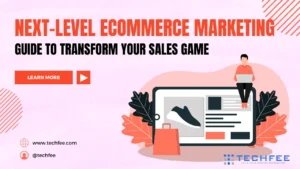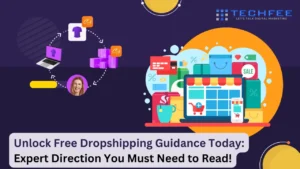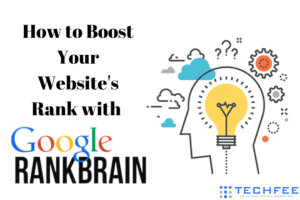By using effective email marketing strategies, your email marketing campaigns can bring a return on investment (ROI) of up to 4400%. Email marketing has the potential to be one of the most effective ways to connect and engage with your target audience. However, with so many emails flooding your audience’s inbox daily, how can you ensure your email campaign stands out?
This article will discuss effective email marketing strategies to help you create a compelling and engaging campaign that will resonate with your audience. We’ll cover everything from crafting the perfect subject line to optimizing your email content.
To begin with, it is crucial to know your target audience and tailor your emails accordingly. Your email content should be engaging, informative, and relevant to your audience.
Additionally, timing plays a critical role in email marketing. Sending emails at the right time can increase open and click-through rates, resulting in a more successful campaign.
But these are just the basics. This article will explore effective email marketing strategies to help take your campaign to the next level. We will also provide insights from industry experts to ensure that the strategies we discuss are effective and trustworthy.
Whether you are new to email marketing or looking to enhance your existing campaigns, keep reading to discover valuable insights and tips to help you achieve your email marketing goals.
Table of Contents
ToggleWhat Is Email Marketing?
Email marketing is a popular digital marketing tactic that involves sending commercial or promotional messages via email to a group of people. Email marketing aims to build strong customer relationships, improve brand awareness, and increase sales or conversions.
Marketers use email marketing to distribute newsletters, event invites, special offers, and other content to their subscribers. They can also customize email campaigns to target specific groups of people based on demographics, interests, or behaviors.
A well-executed email marketing campaign requires a well-crafted message, an engaged audience, and reliable tools to measure and optimize its success.
How Does Email Marketing Work?
Email marketing has become a standard digital marketing technique businesses use to interact with their intended audience. It involves developing an email list of individuals who have consented to receive promotional emails from the business.
This list can be divided based on various factors such as age, gender, interests, and buying behavior.Once the list is established, businesses can create and send emails to their subscribers. The content of these emails can vary, including newsletters, promotional offers, and other marketing messages.
To ensure subscribers open and read emails, businesses must create captivating subject lines, personalized messages, and visually appealing designs.
Tracking metrics like open rates and click-through rates are essential to gauge the effectiveness of email campaigns. In addition, analyzing these metrics helps businesses adjust their email marketing strategies to improve outcomes.
In short, email marketing is a powerful tool for businesses to establish connections with customers and achieve growth.
Why Is Email Marketing Important?
Email marketing is an essential part of modern marketing strategies for various reasons. For one, it allows businesses to communicate directly with their customers.
Additionally, email marketing is an affordable way to reach a large audience and generate leads. Moreover, email marketing enables businesses to send personalized messages tailored to specific audiences based on their interests and behaviors.
As a result, email marketing can help businesses build strong relationships with their customers and keep them engaged with their brands.
Email marketing is invaluable for businesses looking to increase customer engagement, generate leads, and boost sales.
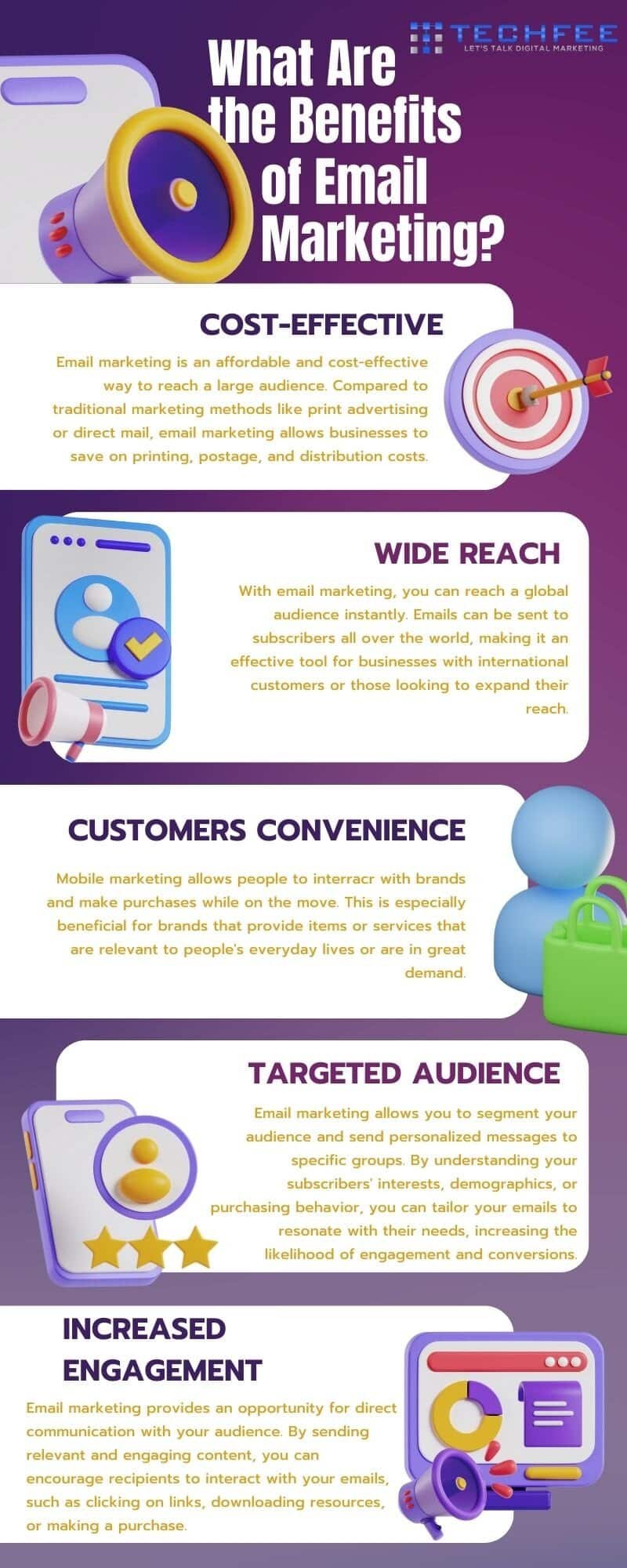
How to Create Effective Email Marketing Strategies
To develop an effective email marketing plan, it’s crucial to begin by establishing a clear objective. This goal could vary, including increasing sales, enhancing brand awareness, or driving traffic to your website. Once you’ve determined your purpose, the next step is to organize your email list based on demographics, past purchases, and interests.
This allows you to create targeted, personalized messages connecting with your audience. Another essential aspect is to craft captivating subject lines and engaging email content that adds value to your subscribers.
Lastly, it’s vital to monitor and analyze your email marketing metrics, such as open and click-through rates, to assess the efficacy of your campaigns and continuously improve your plan over time.
Let’s delve into each of these strategies in detail:
1. Building Your Email List
Creating a successful email marketing plan begins with building your Email List. Although daunting, the process can be broken down into simple steps. First and foremost, you need to identify your target audience and create an enticing lead magnet that will motivate them to sign up for your list.
This lead magnet could be a free e-book, whitepaper, discount code, or an exclusive offer that provides value to your audience.
Once you have your lead magnet, you can promote it through various channels like social media or your website to drive traffic to your opt-in page.
It’s essential to ensure that your opt-in page is straightforward to understand so that people can easily subscribe to your email list. Following these steps, you can create a high-quality email list to help you achieve your email marketing objectives and grow your business.
2. Crafting Effective Subject Lines
Composing effective subject lines is crucial to crafting an email marketing campaign strategy that yields positive outcomes. As the first thing a recipient encounters, subject lines can determine whether or not they choose to open an email.
To ensure success, subject lines must be brief, captivating, and accurately represent the contents of the email. In addition, it’s critical to remember the intended audience and their interests, as well as any personalization opportunities that can make the subject line feel more customized to the individual recipient.
Finally, investing time in generating a solid subject line can significantly enhance email open rates and foster greater engagement with the target audience.
3. Designing Your Emails
If you want to write emails that make an impact, there are several essential factors you need to consider. One of the most crucial aspects is selecting a suitable email template, which should be visually appealing and in line with your brand identity.
This helps to establish credibility and makes it easier for your recipients to engage with your content.
In addition to email marketing templates, you should incorporate visually appealing elements such as images, graphics, and colors to catch readers’ attention and make your message more memorable.
However, you should keep the layout simple and easy to navigate, use clear and concise language, and optimize for mobile devices to ensure your email is adequate.By following these best practices for email design, you can create emails that look great and effectively communicate your message to your audience.
Remember, a well-designed email can help establish professionalism and make a lasting impression on your recipients.
4. Writing Effective Email Copy
Crafting impactful email content is crucial for individuals and organizations who wish to communicate effectively with their target audience.
The importance of email content cannot be overstated, as it can significantly affect a business’s reputation and connection with its clients.
To create compelling emails that achieve desired results, several tips must be kept in mind when developing engaging email content:
- An intriguing and concise subject line is crucial.
- The focus should be on highlighting the benefits of the message rather than just its features.
- It’s essential to keep email content brief and to the point while still conveying all the necessary information.
- Proofreading is critical to ensure no spelling or grammatical errors before sending the email.
Adhering to these email marketing best practices guarantees that emails will be powerful and engaging, resulting in increased interest and conversions from the audience.
5. Using & Optimizing Calls-To-Action
Calls-to-Action (CTAs) play a pivotal role in email marketing by encouraging recipients to engage with your content and complete a specific action, ultimately leading to higher conversion rates.
Effective CTAs are particularly valuable as they help direct your readers toward a specific goal, such as purchasing, signing up for a subscription, or downloading content.
Crafting compelling CTAs can be daunting, but there are some helpful tips to remember.
For example, using language that emphasizes action, creating a sense of urgency, and keeping the message brief are all effective strategies. In addition, phrases like “Buy Now,” “Learn More,” and “Sign Up Today” are great examples of CTAs that convey the desired action and motivate readers to take action.
By incorporating these tactics, you can boost the effectiveness of your CTAs and drive higher conversion rates through your email marketing efforts.
6. Optimizing Your Emails
Ensuring your emails are effective is essential for any successful email marketing campaign. A powerful technique for improving your email performance is through A/B testing.
This method involves sending two versions of the same email to a small group and analyzing the outcomes to see which resonates better with your audience.
Additionally, measuring and examining metrics like open rates, click-through rates, and conversion rates in the optimization process is crucial. This way, you can pinpoint areas that require improvement and make data-driven choices to increase engagement.
To optimize your emails, focus on creating a clear and concise subject line, personalizing your content, designing for mobile devices, and segmenting your email list based on subscriber behavior and interests.
7. Sharing User-Generated Content
Incorporating user-generated content into email marketing can be a game-changer. By leveraging customer-generated content, businesses can showcase their brand’s authenticity and build a sense of community.
Testimonials, reviews, photos, and videos are all examples of user-generated content that can be used to create a compelling email campaign. This type of content provides tangible benefits to the audience, allowing them to see real-life experiences of a brand’s products or services.
In addition, encouraging customers to share their experiences can also be an effective way to increase engagement and trust with the audience.
Using user-generated content in email marketing can help businesses establish an authentic and meaningful connection with their subscribers.
8. Adding Visuals
Email marketing is an effective way to reach your target audience and promote your products or services. But getting noticed amidst the emails in your subscribers’ inboxes can take much work. That’s why including visual elements in your emails can make a huge difference.
Adding images, videos, infographics, and other visually appealing aids can make your message more engaging and exciting. Plus, it can break up long paragraphs of text and make your email more readable.
However, using visuals thoughtfully is essential, and avoid managing your audience with only a few images or large file sizes. Otherwise, it could slow down the email loading time, causing frustration and potentially losing subscribers.
You can increase engagement, improve brand recognition, and drive more conversions by strategically incorporating visual elements in your email marketing strategy. So, take advantage of the power of visuals and boost your email campaigns!
9. Testing Copy, Design, And Buttons
To make your email marketing campaign more effective, you must conduct tests on your copy, design, and buttons. Your email copy should be brief and straightforward, conveying your message clearly and effectively.
Your email design should be visually pleasing and align with your brand identity. Additionally, your buttons should be easy to spot and click, making it easy for your subscribers to take action.
Through testing different variations of these elements, you can identify which ones work best for your audience and optimize your email marketing campaign accordingly.
Regularly testing and optimizing your email marketing can increase engagement, resulting in higher open and click-through rates and ultimately improving conversion rates.
10. Running Trigger-Based Campaigns
One of the most effective email marketing strategies is using trigger-based campaigns. This method involves sending subscribers emails based on specific actions, like signing up for a newsletter, leaving a shopping cart, or purchasing.
Trigger-based campaigns are carefully targeted and relevant, which can lead to higher rates of engagement and conversion. In addition, by automating the process, marketers can save time and resources while still providing personalized experiences for their subscribers.
Overall, incorporating trigger-based campaigns can be a powerful way to improve the effectiveness of your email marketing efforts.
11. Sending Mobile Friendly Emails
Sending emails to your audience is an essential part of communication, and it’s vital to ensure they are easily accessible on mobile devices. Nowadays, many people use their mobile phones to check emails, and an email that is not mobile-friendly can cause frustration and lead to lower engagement rates.
To create mobile-friendly emails, there are several tips to keep in mind:
Firstly, ensure that your subject line is short and to the point. A long subject line can be challenging to read on a smaller screen.
Secondly, make use of a responsive email design. This ensures that your email’s layout adjusts according to the screen size it’s being viewed on.
Thirdly, use a single-column layout that is easier to read on a mobile device, unlike a multi-column design.
Fourthly, use a font size of at least 14px, which is large enough to be read easily on a mobile screen.
Fifthly, keep your language clear and concise, as mobile users are usually on the go and only have a little time to read lengthy emails.
Sixthly, only use images that are too large or take a long time to load, as they can slow down the loading time of your email and make it difficult to view on a mobile device.
Finally, ensure your call-to-action is clear and easy to tap on a mobile device. Ensure your button or link is large enough to be clicked on a smaller screen.
By implementing these tips, you can create mobile-friendly emails that are easy to read and engage your audience.
12. Automating Your Email Campaigns
Automating your email campaigns can offer numerous benefits to your company. It saves you time and effort while ensuring consistency and improving the customer experience.
Automation’s ability to send personalized and timely emails triggered by your subscribers’ actions makes it crucial. This includes welcome emails, abandoned cart reminders, and post-purchase follow-ups, which can be automated to increase engagement, conversions, and customer loyalty.
To successfully set up automated email campaigns, you must clearly understand your goals, segment your audience, create compelling subject lines and content, and regularly test and optimize your campaigns.
Following these tips, you can effectively use automated email campaigns to drive business growth and enhance customer satisfaction.
13. Integrating Email With Your Other Marketing Channels
Integrating your email with other marketing channels is a powerful way to enhance the impact of your campaigns. A creative approach to this is promoting your emails on social media platforms.
By sharing exciting snippets or teasers of your emails, you can grab your followers’ attention and encourage them to join your email list.
Another effective way to incorporate email into your marketing strategy is by using it as a distribution channel for your content marketing efforts.
This means sending your subscribers your blog posts, e-books, and whitepapers. This approach can drive traffic to your website and increase engagement with your content.
Lastly, including links to your website in your emails can also drive traffic. By promoting your products, services, or offers in your email campaigns and linking them to specific landing pages on your website, you can generate more traffic to your website.
Integrating your email with other marketing channels can increase your reach and engagement, drive website traffic, and boost conversions and sales.
14. Nurturing Your Leads
Lead nurturing is cultivating relationships with potential customers, also known as leads, to guide them toward making a purchase. The process requires a thorough understanding of your target audience and a well-planned approach to communication.
To effectively nurture leads, it is essential to segment them based on factors such as industry, demographics, and behavior. This helps you personalize your communication and deliver the right message to the right person at the right time.
Using multiple channels such as email, social media, and direct mail also increases your chances of reaching your audience where they are.
Instead of bombarding leads with sales pitches, providing them with valuable content that solves their problems or answers their questions is advisable. This can include blog posts, whitepapers, webinars, and more. Consistency is also essential in the lead nurturing, as it helps build trust and keeps the brand on top of your mind.
It is essential to measure the effectiveness of your lead nurturing campaigns using analytics to refine your approach and improve your results over time.
Effective lead nurturing campaigns include drip email, social media, webinars, and direct mail.
Each campaign provides valuable information, builds relationships, and moves the lead further along the buying journey.
15. Personalizing Your Emails
When it comes to email marketing, personalization is critical to success. Research shows personalized emails have higher open and click-through rates than generic ones. Personalization is important because it makes your customers feel valued and understood.
Information about your customers’ preferences, interests, and behavior is essential to personalize your emails. This can be achieved by using sign-up forms, tracking website activity, and asking for feedback.
To personalize your emails, you can address your customers by name, offer customized deals based on their previous purchases, and segment your email list based on their geographic location or interests.
Personalizing your emails can build stronger relationships with your customers and increase the likelihood of turning them into loyal customers.
16. Segmenting Your Subscribers
Dividing your email list into smaller groups based on similar characteristics can significantly affect engagement and conversion rates.
By segmenting your subscribers based on demographics, behavior, or preferences, you can create messages tailored to their specific needs and interests.
For example, you could create segments based on their email activity, purchase history, or location. This approach allows you to send more personalized messages that are more likely to resonate with your subscribers and encourage them to take action.
Ultimately, subscriber segmentation can help you achieve better outcomes and a higher return on investment by making your email marketing campaigns more effective and relevant to your audience.
17. Re-Engaging Inactive Subscribers
To have a successful email marketing strategy, keeping your subscribers engaged and interested in your content is essential. Growing your subscriber list is one thing, but keeping your current subscribers interested is equally crucial.
Having inactive subscribers can negatively impact your email metrics and harm your sender’s reputation. Creating a re-engagement campaign can be a great strategy to address this issue.
This involves identifying inactive subscribers and creating personalized content and offers to encourage them to become active again. Some effective tactics include sending customized emails, offering exclusive discounts, or reminding them of the value of your content.
You can improve your email metrics, build brand loyalty, and increase sales by successfully re-engaging with your subscribers.
18. Using Email To Convert
Email marketing is a powerful tool for turning potential customers into paying ones. But, to succeed, delivering the right message to the right person at the right time is essential.
Email is a crucial part of the conversion process because it enables you to build relationships with potential customers and provide them with valuable information addressing their needs and concerns.
Moreover, using email to address any hesitations or objections can be an intelligent strategy to encourage hesitant prospects to take action. You can achieve this by using case studies, testimonials, or free trial offers to persuade them that your product or service is the best solution for their needs.
There are various effective conversion-oriented emails, including welcome emails, abandoned cart emails, and re-engagement emails. These emails keep potential customers engaged and moving through the sales funnel.
By using email marketing to convert prospects into customers, businesses can increase their sales and expand their customer base.
19. Retaining Customers With Email
Creating a strong and dependable customer base is an integral part of any business’s triumph, and one of the most successful ways to achieve this is through email marketing.
Tailored and individualized emails can keep customers engaged and attracted to a company’s products or services. In addition, these emails should provide value to the receiver, whether through exclusive deals, helpful advice, or enlightening content.
By focusing on the customer’s needs and interests, companies can develop a more solid connection with their target audience and enhance the likelihood of them returning.
Additionally, sending out emails regularly can help keep a brand at the forefront of customers’ minds, making it more probable that they will opt for that brand when they are ready to purchase. Email marketing is a robust tool for creating long-term customer relationships and nurturing loyalty.
20. Creating Email Newsletters
Email newsletter marketing strategies are great for businesses to build and maintain relationships with their audience. These newsletters are highly valued because they provide subscribers with valuable content regularly, which helps keep the brand at the forefront of their minds.
Creating engaging content that resonates with your readers is essential to ensure your newsletters are effective. One way to do this is to personalize the content to match the recipient’s interests and needs.
You should also consider incorporating eye-catching visuals, persuasive headlines, and a clear call to action to keep readers interested and engaged.
Businesses can use various types of successful email newsletters, including weekly roundups, exclusive offers, and educational content.
Successful companies such as BuzzFeed, The Hustle, and Airbnb have all used clever copy, personalized content, and attention-grabbing visuals to keep their subscribers interested and engaged.
You can establish a solid and lasting relationship with your subscribers by following the lead and creating newsletters tailored to your audience’s needs, interests, and preferences.
21. Connecting With Social Media
Companies can combine their social media efforts with email marketing to broaden their reach and connect with a broader audience. Social media provides a valuable opportunity to connect with potential customers and foster relationships with existing ones.
With the right approach, businesses can leverage social media platforms to promote their email marketing campaigns and encourage subscribers to share their content with their networks. This approach can increase brand visibility, higher email open rates, and more conversions.
In summary, integrating social media into email marketing campaigns can be a highly effective strategy for achieving business objectives.
22. Including Catchy Email Signature
An appealing email signature can be a game-changer in developing a successful marketing strategy. An effectively crafted email signature is more than just a means to provide necessary contact information; it can also function as a powerful marketing tool.
By incorporating a captivating tagline or a call to action, you can grab your readers’ attention and motivate them to act.
Additionally, visually pleasing elements such as a company logo or a professional headshot can help build brand recognition and inspire trust from your audience.
Therefore, investing ample time and effort into creating a well-designed email signature that aligns with your brand and marketing goals is crucial.
23. Managing Your Email Marketing Campaigns
Successfully managing email marketing campaigns requires careful planning and execution. Developing a plan tailored to your audience and objectives is the key to a successful strategy.
This involves identifying your target audience, defining your goals, and outlining the important messages you want to convey in your emails. It would be best to create a content calendar to schedule your email marketing activities, including when and how frequently you send emails and what content you include.
To ensure your messages are relevant and targeted to your subscribers, segmenting your email list is a good idea. Testing different subject lines and email formats can help determine what resonates best with your audience.
Additionally, it’s essential to regularly review and analyze your email campaign data to measure your success and identify areas for improvement.
By taking a careful approach to plan and execution, you can create email marketing campaigns that engage and convert your audience. With the right strategy, you can achieve your marketing goals and grow your business through effective email marketing.
24. Sending Emails At The Best Time
One of the most effective ways for businesses to improve engagement and conversions through email marketing is by sending emails at the right time. Unfortunately, the perfect timing for sending emails differs from one audience to another, depending on the type of content being shared.
For example, sending emails during business hours might be more successful if your target audience comprises professionals. However, evenings or weekends could be a better option if your target audience is stay-at-home parents.
By analyzing email open and click-through rates, you can identify the best time to send emails and tailor your email marketing campaigns accordingly.
Ultimately, sending emails at the most suitable time can significantly improve the success of your email marketing campaigns.
25. Ensuring Deliverability
Email deliverability is critical for successful email marketing, as it determines whether an email will reach its intended recipient’s inbox.
Therefore, businesses need to prioritize this aspect of their email campaigns. Failing to do so can result in wasted resources and unsuccessful email marketing efforts.
Various factors can impact email deliverability, including spam filters, blacklists, and invalid email addresses.
To improve email deliverability, businesses should implement best practices such as keeping their email list clean and up-to-date, using a recognizable sender name and email address, avoiding spam trigger words and providing an easy unsubscribe option.
By adopting these practices, businesses can increase the likelihood of their emails reaching their target audience and achieving higher conversion rates.
In conclusion, email deliverability is a crucial element of email marketing that should be noticed. By taking proactive measures to ensure deliverability, businesses can maximize the impact of their email campaigns and achieve their marketing goals.
26. Staying Compliant With Email Regulations
Ensuring your organization complies with email regulations is crucial in avoiding legal complications and costly fines. However, it can be quite challenging to fully comprehend the intricacies of email regulations as they can vary depending on the industry, location, and email type.
To help you maintain compliance, here are some tips that you can follow:
- Keep your email list current: Regularly update it and ensure you only send emails to individuals who have given you explicit consent to contact them.
- Include an opt-out option: Including an opt-out option in your emails is a legal requirement in many email regulations. This will enable recipients to unsubscribe from your email list whenever they want.
- Use clear and accurate subject lines: Ensure that your subject line accurately reflects the content of your email and is not misleading in any way.
- Avoid spam triggers: Avoid using spam triggers such as excessive capitalization, exclamation marks, and certain trigger words in your email content.
- Monitor your email campaigns: Regularly monitor them to ensure they adhere to email regulations and identify potential issues.
Some of the most common email compliance issues include sending unsolicited emails, not including an opt-out option, and using misleading subject lines.
Following these tips and staying informed about email regulations can help your organization remain compliant and prevent any legal issues associated with email marketing.
27. Tracking Your Metrics
Keeping track of specific metrics is essential for any email marketing campaign. Here are some key metrics that you should consider monitoring:
Open Rate: The open rate is the percentage of subscribers who open your email. A higher open rate indicates that your subject line and sender name were persuasive enough to encourage subscribers to open your email.
Click-Through Rate (CTR): The click-through rate measures the percentage of subscribers who clicked on a link in your email. This metric is a gauge of how engaging your email content is.
Conversion Rate: The conversion rate is the percentage of subscribers who take the desired action after clicking on a link in your email. For example, if your email contains a link to purchase a product, the conversion rate would show the percentage of subscribers who made a purchase.
Bounce Rate: The bounce rate is the percentage of emails not delivered to the recipient’s inbox. This can happen if the email address is invalid, the recipient’s mailbox is complete, or the email was marked as spam.
Unsubscribe Rate: The unsubscribe rate is the percentage of subscribers who have opted out of receiving your emails. While losing subscribers over time is normal, a high unsubscribe rate may indicate your email content must resonate with your audience.
By monitoring these metrics, you can gain insights into what’s working and what’s not and adjust your email marketing strategy accordingly.
Conclusion
Email marketing is a highly effective method for businesses to enhance their sales and establish better connections with their clientele.
By utilizing the 27 techniques suggested in this guide, companies can develop successful email campaigns that captivate their target audience and encourage them to take action and generate more revenue.
These tactics include creating attention-grabbing subject lines, customizing content to suit individual customer preferences, and ensuring mobile optimization for a seamless user experience.
By consistently evaluating and improving their strategies, businesses can optimize their email marketing efforts and attain even greater success, resulting in overall growth for their company.
I hope you have found this guide helpful. Which strategies do you like the most? Do let me know in the comment section below.
Frequently Asked Questions
What are some email marketing tips and tricks?
Some tips and tricks for effective email marketing include personalizing your emails, segmenting your email list, using attention-grabbing subject lines, providing valuable content, optimizing for mobile devices, including clear calls to action, testing and analyzing your campaigns, and building a strong email list through opt-ins and lead magnets.
Is email marketing effective?
Yes, email marketing can be very effective when done correctly. It allows businesses to reach their target audience directly and can be personalized to increase engagement. Effective email marketing strategies include:
- Segmenting your audience.
- Creating compelling subject lines and content.
- Analyzing data to improve your campaigns continually.
How to improve email marketing performance?
Some effective email marketing strategies to improve performance include personalization, segmentation, creating engaging subject lines, optimizing for mobile devices, using clear calls to action, and regularly testing and analyzing your campaigns.
How often should I send emails?
The frequency of your email campaigns will depend on your specific business and audience, but generally, it's recommended to send at least one email per month and no more than one per week. However, it's essential to test and analyze your open and click-through rates to determine the optimal frequency for your audience.
How do I measure the success of my email campaigns?
You can use several metrics to measure the success of your email campaigns, including open rates, click-through rates, conversion rates, and unsubscribe rates. You can also track revenue generated from your campaigns and compare it to the cost of running them to determine your return on investment (ROI). It's important to regularly analyze these metrics and adjust your strategy as needed to improve your results.
What are some common email marketing mistakes to avoid?
Some common email marketing mistakes to avoid include:
- Sending too many emails.
- Not personalizing the content.
- Using a generic subject line.
- Not segmenting your audience.
- Not optimizing for mobile devices.
- Not having a clear call-to-action.
- Not testing your emails.
- Not cleaning your email list.
- Not following email marketing laws and regulations.
- Not analyzing your email marketing metrics.
How can I become an Email Marketer?
To become an Email Marketer, follow these steps:
- Learn email marketing fundamentals: Familiarize yourself with the basic concepts, strategies, and best practices of email marketing. Study online resources, articles, and courses to gain knowledge.
- Build your technical skills: Gain proficiency in email marketing tools and software, such as Mailchimp, Constant Contact, or Sendinblue. Learn how to create and manage email campaigns, track metrics, and analyze data.
- Develop copywriting skills: Learn to write persuasive and engaging email content. Focus on crafting compelling subject lines, captivating introductions, and clear calls to action. Practice writing concise, targeted messages that resonate with your audience.
- Understand audience segmentation: Learn segmentation techniques to divide your email list based on demographics, interests, or behaviors. Tailoring your messages to specific segments increases engagement and conversion rates.
- Familiarize yourself with email regulations: Stay updated on email marketing laws and regulations, such as the CAN-SPAM Act and GDPR. Understand the consent, opt-outs, and data privacy rules to ensure compliance.
- Gain practical experience: Seek opportunities to apply your skills through internships, freelance projects, or by assisting with email marketing campaigns for organizations. Hands-on experience will strengthen your understanding and boost your resume.
- Stay updated with industry trends: Follow industry blogs, newsletters, and podcasts to stay informed about the latest trends, strategies, and innovations in email marketing. Attend relevant webinars or conferences to expand your knowledge.
- Build a portfolio: As you gain experience, create a portfolio showcasing your successful email campaigns and results. This will prove your skills and help you stand out when seeking job opportunities.
- Network and seek opportunities: Connect with professionals in the field, join online communities or forums, and attend industry events to expand your network. Network with potential employers or clients who may have email marketing needs.
- Keep learning and adapting: Email marketing constantly evolves, so continue learning and experimenting with new strategies. Stay up-to-date with emerging technologies, automation tools, and personalization techniques to remain competitive.
By following these steps and continuously refining your skills, you can become a proficient Email Marketer and open up opportunities in this field.
What are the four types of marketing emails?
The four marketing emails are promotional, informational, transactional, and lead nurturing emails.
What is a reasonable open rate for email marketing?
A reasonable open rate for email marketing typically falls within the range of 15% to 25%, although this can vary depending on the industry and the quality of the email list.
How to get email lists for marketing?
To acquire email lists for marketing, you can employ strategies such as:
- Building your list: Offer valuable content or incentives on your website or through social media to encourage visitors to subscribe to your email list.
- Partnering with complementary businesses: Collaborate with businesses in related industries and exchange email lists to expand your reach.
- Purchasing email lists: Be cautious when purchasing them, as it's essential to ensure they are from reputable sources and comply with applicable data protection regulations.
- Using lead generation tools: Utilize tools and platforms to capture email addresses from interested individuals who visit your website or engage with your content.
How much does email marketing cost?
The cost of email marketing can vary depending on several factors, such as the size of your email list, the frequency of your campaigns, and the email marketing service provider you choose. Generally, email marketing costs can range from free for basic plans with limited features to hundreds or even thousands of dollars per month for more extensive lists and more advanced features. Researching and comparing pricing plans from different providers is advisable to find the best fit for your needs and budget.
What is one of the benefits of using templates for your email marketing campaigns?
One of the benefits of using templates for your email marketing campaigns is that they provide a consistent and professional design, which can enhance your brand's image and make your emails more visually appealing to recipients.
In email marketing, what is a relationship email?
In email marketing, a relationship email refers to communication that focuses on building and nurturing a connection with the recipients. These emails are designed to establish trust, provide value, and engage with subscribers more personally, ultimately fostering long-term relationships with customers.
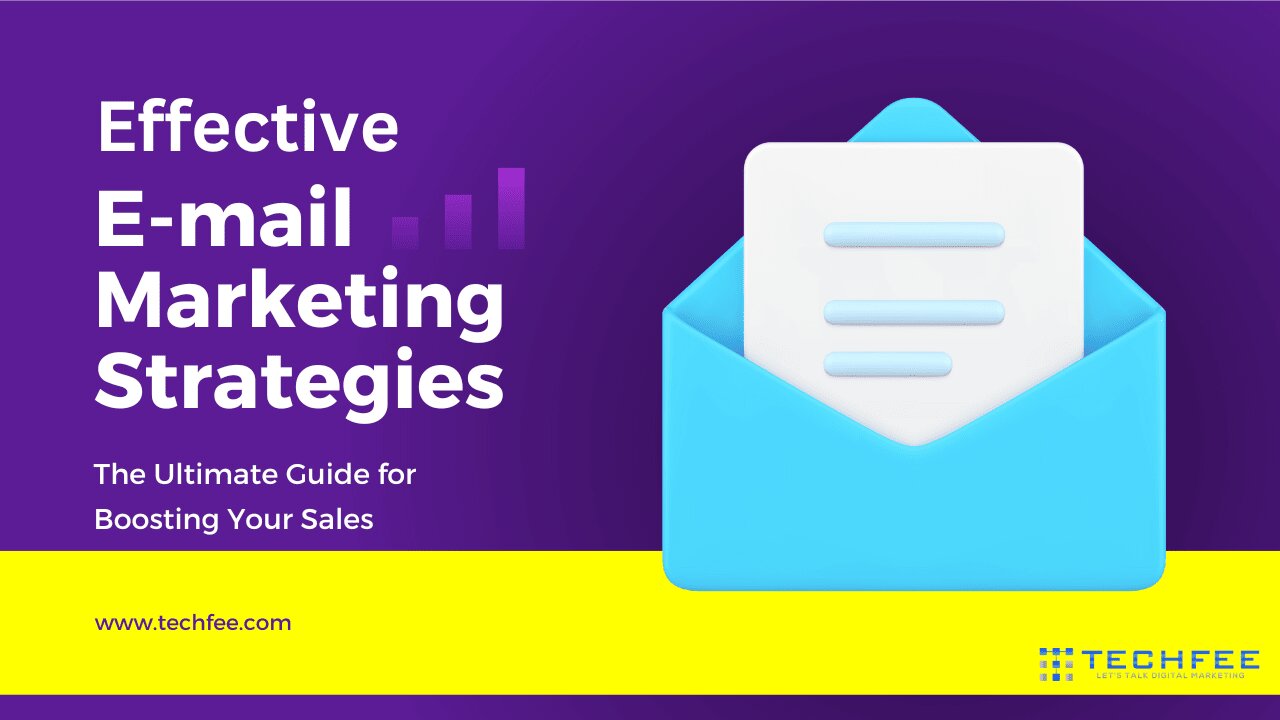


 Twitter
Twitter Facebook
Facebook Linkedin
Linkedin
